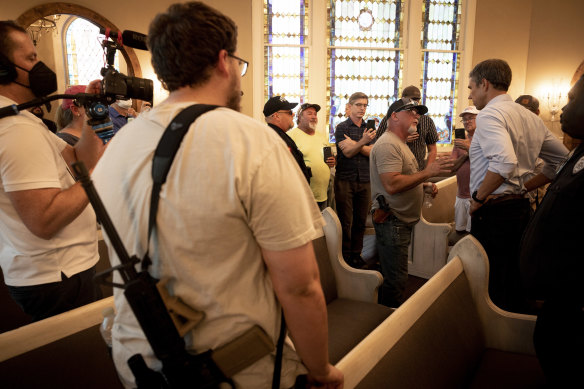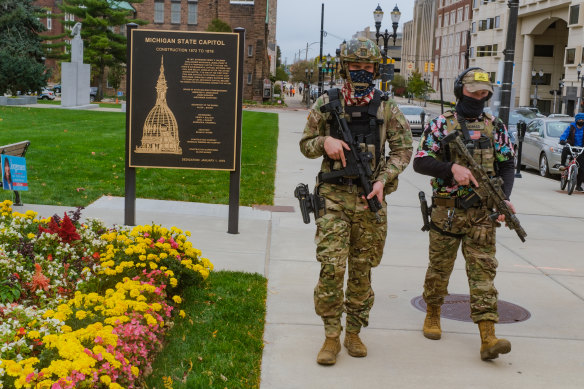
Across the United States, openly carrying a gun in public is no longer just an exercise in self-defence — increasingly it is a soapbox for elevating one’s voice and, just as often, quieting someone else’s.
This month, armed protesters appeared outside an elections centre in Phoenix, hurling baseless accusations that the election for governor had been stolen from the Republican, Kari Lake. In October, Proud Boys with guns joined a rally in Nashville, Tennessee, where conservative lawmakers spoke against transgender medical treatments for minors.
Beto O’Rourke, right, the Democratic candidate for governor, speaks with Rod Parker, a revivalist preacher with a .40-caliber handgun who had been protesting outside, in Whitesboro, Texas in July.Credit:New York Times
In June, armed demonstrations around the United States amounted to nearly one a day. A group led by a former Republican state legislator protested a gay-pride event in a public park in Coeur d’Alene, Idaho. Men with guns interrupted a Juneteenth festival in Franklin, Tennessee, handing out flyers claiming that white people were being replaced.
(Juneteenth celebrates the news of the freeing of black slaves reaching the southern states following the US Civil War.)
Among the others were rallies in support of gun rights in Delaware and abortion rights in Georgia.
Whether at the local library, in a park or on Main Street, most of these incidents happen where Republicans have fought to expand the ability to bear arms in public, a movement bolstered by a recent Supreme Court ruling on the right to carry firearms outside the home. The loosening of limits has occurred as violent political rhetoric rises and police in some places fear bloodshed among an armed populace on a hair trigger.
Armed Americans, often pushing a right-wing agenda, are increasingly using open-carry laws to intimidate opponents and shut down debate.Credit:New York Times
But the effects of more guns in public spaces have not been evenly felt.
A partisan divide — with Democrats largely eschewing firearms and Republicans embracing them — has warped civic discourse. Deploying the Second Amendment in service of the First Amendment has become a way to buttress a policy argument, a sort of silent, if intimidating, bullhorn.
“It’s disappointing we’ve gotten to that state in our country,” said Kevin Thompson, executive director of the Museum of Science & History in Memphis, Tennessee, where armed protesters led to the cancellation of an LGBTQ event in September. “What I saw was a group of folks who did not want to engage in any sort of dialogue and just wanted to impose their belief.”
A New York Times analysis of more than 700 armed demonstrations found that at about 77 per cent of them, people openly carrying guns represented right-wing views, such as opposition to LGBTQ rights and abortion access, hostility to racial justice rallies and support for former President Donald Trump’s lie of winning the 2020 election.
The records, from January 2020 to last week, were compiled by the Armed Conflict Location & Event Data Project, a nonprofit that tracks political violence around the world. The Times also interviewed witnesses to other, smaller-scale incidents not captured by the data, including encounters with armed people at indoor public meetings.
Anti-government militias and right-wing culture warriors such as the Proud Boys attended a majority of the protests, the data showed. Violence broke out at more than 100 events and often involved fisticuffs with opposing groups, including left-wing activists such as antifa.
Republican politicians are generally more tolerant of openly armed supporters than are Democrats, who are more likely to be on the opposing side of people with guns, the records suggest. In July, for example, men wearing sidearms confronted Beto O’Rourke, then the Democratic candidate for Texas governor, at a campaign stop in Whitesboro and warned that he was “not welcome in this town”.
Republican officials or candidates appeared at 32 protests where they were on the same side as those with guns. Democratic politicians were identified at only two protests taking the same view as those armed.
Sometimes, the Republican officials carried weapons: Robert Sutherland, a Washington state representative, wore a pistol on his hip while protesting COVID-19 restrictions in Olympia in 2020. “Governor,” he said, speaking to a crowd, “you send men with guns after us for going fishing. We’ll see what a revolution looks like.”
The occasional appearance of armed civilians at demonstrations or governmental functions is not new. In the 1960s, the Black Panthers displayed guns in public when protesting police brutality. Militia groups, sometimes armed, rallied against federal agents involved in violent standoffs at Ruby Ridge, in Idaho, and in Waco, Texas, in the 1990s.
But the frequency of these incidents exploded in 2020, with conservative pushback against public health measures to fight the coronavirus and response to the sometimes violent rallies after the murder of George Floyd. Today, in some parts of the country with permissive gun laws, it is not unusual to see people with handguns or military-style rifles at all types of protests.
For instance, at least 14 such incidents have occurred in and around Dallas and Phoenix since May, including outside an FBI field office to condemn the search of Trump’s home and, elsewhere, in support of abortion rights. In New York City and Washington, D.C., where gun laws are strict, there were none — even though numerous demonstrations took place during that same period.
Gun-rights advocates assert that banning guns from protests would violate the right to carry firearms for self-defence. Jordan Stein, a spokesperson for Gun Owners of America, pointed to Kyle Rittenhouse, a teenager acquitted last year in the shooting of three people during a chaotic demonstration in Kenosha, Wisconsin, where he had walked the streets with a military-style rifle.
“At a time when protests often devolve into riots, honest people need a means to protect themselves,” he said.
Beyond self-defence, Stein said the freedom of speech and the right to have a gun are “bedrock principles” and that “Americans should be able to bear arms while exercising their First Amendment rights, whether that’s going to church or a peaceful assembly”.
Others argue that openly carrying firearms at public gatherings, particularly when there is no obvious self-defence reason, can have a corrosive effect, leading to curtailed activities, suppressed opinions or public servants who quit out of fear and frustration.
In a landmark 2008 decision in District of Columbia v Heller, the Supreme Court held that the Second Amendment conveyed a basic right to bear arms for lawful purposes such as self-defence at home. It went further in a decision in June that struck down New York restrictions on concealed-pistol permits, effectively finding a right to carry firearms in public.
But the court in Heller also made clear that gun rights were not unlimited and that its ruling did not invalidate laws prohibiting “the carrying of firearms in sensitive places.” That caveat was reiterated in a concurring opinion in the New York case.
Even some hard-line gun-rights advocates are uncomfortable with armed people at public protests. Alan Gottlieb, founder of the Second Amendment Foundation, told The Washington Times in 2017 that “if you are carrying it to make a political point, we are not going to support that”.
“Firearms serve a purpose,” he said, “and the purpose is not a mouthpiece.”
There is no evidence that the framers of the Constitution intended for Americans to take up arms during civic debate among themselves — or to intimidate those with differing opinions. That is what happened at the Memphis museum in September, when people with guns showed up to protest a scheduled dance party that capped a summerlong series on the history of the LGBTQ community in the South.
Although the party was billed as “family friendly,” conservatives on local talk radio claimed that children would be at risk. (The museum said the planned activities were acceptable for all ages.) As armed men wearing masks milled about outside, the panicked staff cancelled all programs and evacuated the premises.
Thompson, the director, said he and his board were now grappling with the laws on carrying firearms, which were loosened last year by state legislators.
“It’s a different time,” he said, “and it’s something we have to learn to navigate.”
This article originally appeared in The New York Times.
Most Viewed in World
From our partners
Source: Read Full Article

